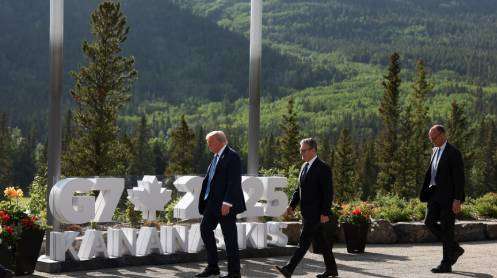
Introduction
At the G7 summit held in Kananaskis, Canada, world leaders issued a joint statement urging a “de-escalation of hostilities” across the Middle East — including Gaza — while notably avoiding any direct call for a ceasefire between Israel and Iran. The carefully worded statement reflects growing divisions among global powers as the Israel-Iran conflict spirals into one of the most serious regional escalations in decades. [BBC Source]

Trump Leaves G7 Summit Early Amid Middle East Tensions
The summit took an unexpected turn when US President Donald Trump abruptly left early, citing “big stuff” back in Washington. His press secretary linked his departure to unfolding events in the Middle East, though Trump himself denied it was tied to ceasefire negotiations. Speaking on Truth Social, he stated: “Wrong! [Emmanuel Macron] has no idea why I am now on my way to Washington. Much bigger than that. Stay Tuned!”
Trump’s sudden exit means he missed scheduled meetings with Ukrainian President Volodymyr Zelensky and Mexican President Claudia Sheinbaum.
G7 Statement: Diplomatic Balancing Act
The G7’s final communique reaffirmed Israel’s right to self-defense while singling out Iran as the main source of regional instability. “Iran can never have a nuclear weapon,” the statement emphasized. However, by stopping short of demanding an immediate ceasefire, the G7 preserved internal unity while diluting the statement’s impact. [Reuters]

French President Emmanuel Macron voiced hopes for a ceasefire but acknowledged Washington’s complex calculations. “If the United States can achieve a ceasefire, that’s a very good thing,” Macron said diplomatically.
Explosions in Tehran as Conflict Escalates
Shortly after Trump’s social media posts, Iranian media reported multiple explosions and anti-aircraft fire in Tehran. The Israeli military struck Iran’s state broadcaster, forcing live anchors to flee on air. Meanwhile, air raid sirens rang across Tel Aviv as Iran responded with fresh missile attacks, leading to growing fears of full-scale war. [BBC Coverage]
Israel claims its air offensive since last Thursday has killed top Iranian military commanders and scientists, though analysts say Iran’s nuclear infrastructure remains largely intact. Only the United States possesses the bunker-busting capabilities required to penetrate Iran’s deeply fortified facilities like Fordow.
Death Toll Mounting
The Iranian Health Ministry reports at least 224 deaths from Israeli strikes. Israel, meanwhile, reports at least 24 fatalities from Iranian missile attacks. The rising toll underscores the stakes of the rapidly escalating conflict.

US Military Posture Shifts
While denying active involvement, the Pentagon announced new military deployments to the region to bolster its defensive posture. US Defence Secretary Pete Hegseth stated these moves were precautionary amid rising regional instability.
Geopolitical Fractures at the G7
Beyond the Israel-Iran crisis, tensions flared at the G7 over Russia’s war in Ukraine. Trump argued that Russia’s expulsion from the former G8 was a mistake, boasting of his personal rapport with President Putin: “Putin speaks to me. He doesn’t speak to anybody else.”
Despite these tensions, Trump did reach some economic milestones, signing a US-UK trade deal and hinting at a potential US-Canada agreement within 30 days, after meetings with Canadian PM Mark Carney and UK PM Keir Starmer. [US Foreign Policy Updates]
Conclusion: Global Stakes Remain High
The G7 summit showcased the growing fragility of international diplomacy as global powers struggle to contain rapidly spreading conflicts. With Israel and Iran locked in an increasingly bloody exchange and world leaders divided on how to proceed, the risk of wider war looms large. The absence of a unified G7 demand for an Israel-Iran ceasefire reflects both political caution and stark differences in global strategy. [Middle East Conflict Coverage]









